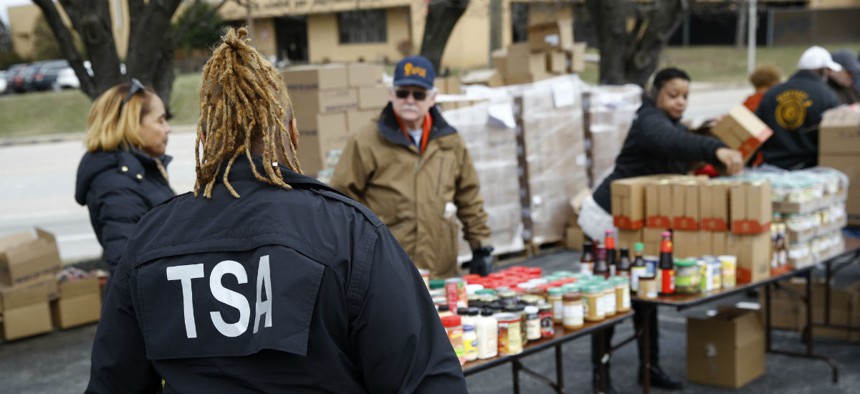
TSA employee Princess Young visits a food pantry for furloughed government workers affected by the federal shutdown on Jan. 23 in Baltimore. Patrick Semansky/AP
Agencies Are Shutting Down More Activities, Furloughing More Workers as Funds Run Dry
Depleted funds from prior years and collected fees could sink agencies that had kept themselves afloat.
While the Trump administration has recently called tens of thousands of furloughed employees back to work unpaid, the unprecedented length of the current partial government shutdown is now forcing home many employees that had been working.
That number is likely to continue to grow as agencies that had leftover appropriated or fee-collected funds are seeing their existing resources depleted as the shutdown enters its second month. Most employees working without pay during the shutdown are labeled “excepted” employees—meaning they are required to report because they protect life or property—though some are deemed “exempted” because they draw their salaries from sources other than annual appropriated funds. The number in the latter category is higher this year due to guidance from the Office of Management and Budget instructing agencies to be creative in keeping employees on the job.
The General Services Administration, for example, said at the outset of the shutdown it would furlough just 5 percent of its 11,000 employees. All of the 5,200 employees at the agency’s Public Buildings Service were deemed exempt due to carryover funds. In an updated plan released this week, GSA noted that it has now furloughed most of those employees. None are exempt and just 1,100 are considered excepted. More than 40 percent of GSA’s workforce is now furloughed.
GSA may soon be forced to shutter even more activities. More than 3,200 employees are currently exempted and working at the Federal Acquisition Service, but that could change. GSA noted that FAS has an alternative stream and is “not immediately affected by a lapse in appropriations.”
The Patent and Trademark Office is currently open and functioning normally. The agency has warned employees that could soon change, however, as prior-year, fee-collected funds run dry.
“The USPTO anticipates that it will have sufficient funds from other than current-year appropriations to continue full operations for a brief period after a general lapse in appropriations commences,” the Commerce Department wrote in its shutdown plan. “Therefore, all employees of the USPTO will be excepted for such period following a lapse in appropriations.”
Once that period ends, USPTO will furlough more than 12,000 employees, leaving less than 1 percent of its workforce on the job.
“Should the USPTO exhaust these funds before a partial government shutdown comes to an end, the agency would have to shut down at that time, although a small staff would continue to work to receive new applications” and various other functions, said Paul Fucito, an agency spokesman. He said USPTO has not yet calculated a “hard and fast date” for when the shutdown would commence, but it has recently updated employees to warn them about a looming closure.
The Justice Department also has fewer employees working that it did at the beginning of the shutdown. Just 5,200 employees are currently working on exempted status, down from 6,400 at the beginning of the shutdown. Justice noted in its plan that the number of employees working at the start of the shutdown included those “funded with carryover, multi-year and no-year funding appropriated in prior years. The number of excepted employees in this category may decrease over the course of an appropriations lapse as carryover funding is depleted.”
The Agriculture Department is also at risk of sending more employees home and ceasing activities that have so far continued throughout the shutdown. John Haynes, a spokesman for the Forest Service, said he would not speculate on when the agency would run out of money for currently exempted work, but called the situation “ever-evolving.”
The Forest Service “is assessing and prioritizing activities we are able to maintain during the lapse in funding based on three categories of work identified in the agency shutdown plan,” Haynes said. “The agency is also evaluating and proceeding with some work using non-appropriated funds to continue critical business functions and public services. These choices continue to evolve as the lapse in funding status persists and more critical needs emerge.”
Nearly half of the 22,000 Forest Service employees working at the start of the shutdown were doing so because they drew their salaries from available funds. Haynes did not offer an updated figure, but the agency has started to cancel fire training courses for staff and local governments and is limiting its hazardous fuel treatments. It is already selectively choosing which fuels to treat “using funds from prior years, if those operations can be performed safely to take advantage of limited opportunities.” Restrooms at national forests across the country are either closed or open with limited maintenance.
At USDA’s Natural Resource Conservation Service, virtually all of its more than 9,000 employees were deemed exempt because of existing funding. In December, NRCS said in a shutdown plan it would not have any exempt employees and would retain just a handful of excepted staff. Prior to the shutdown actually starting, however, the agency reversed course. Kaveh Sadeghzadeh, a NRCS spokesman, said the agency is still operational and does not yet have a cutoff date for when existing funds will run out.
Some agencies previously announced they had depleted their carryover funds. The Environmental Protection Agency, for example, furloughed nearly all of its 14,000 employees in the second week of the shutdown and ceased virtually all operations.







